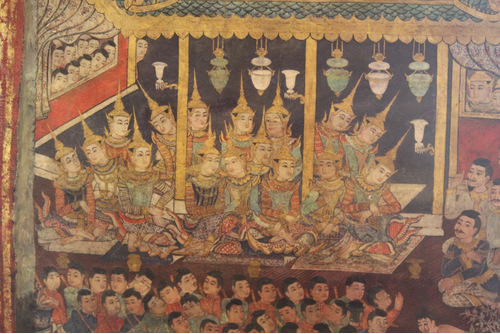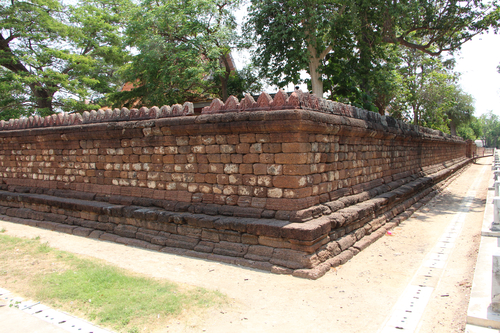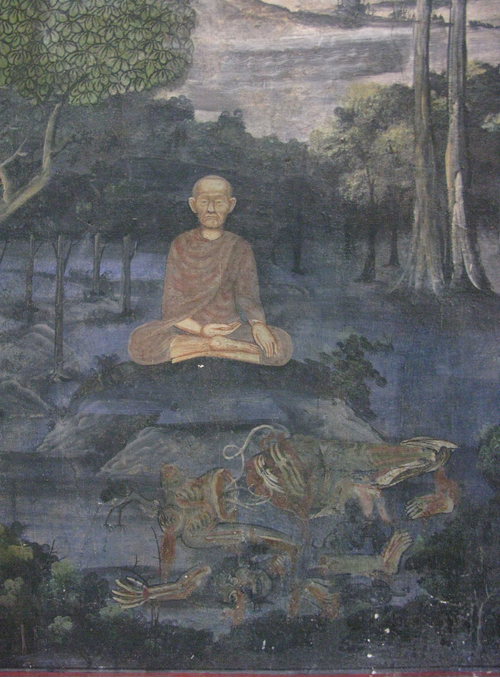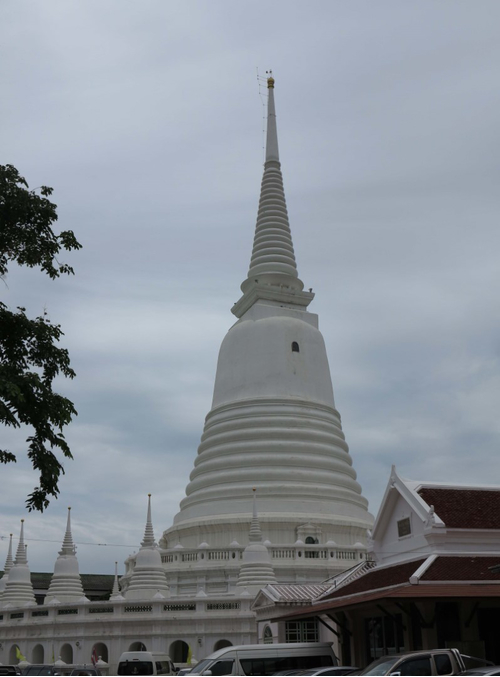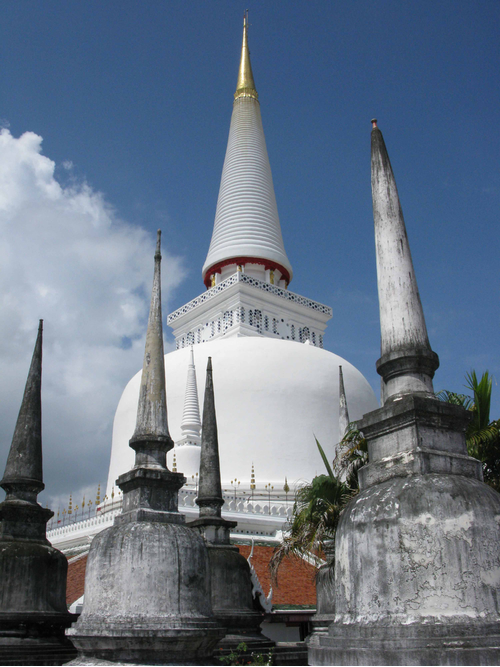ค้นหางานศิลปกรรม
ฐานข้อมูลศิลปกรรมในเอเชียตะวันออกเฉียงใต้
จิตรกรรมจิตรกรรมฝาผนังในวิหารลายคำ
จิตรกรรมฝาผนังที่วิหารลายคำมีหลายส่วน บริเวณผนังห้องท้ายวิหารเขียนภาพพระอดีตพุทธเจ้าเรียงแถว ผนังด้านทิศเหนือเขียนเรื่องสุวรรณหงส์ ผนังด้านทิศใต้เขียนเรื่องสังข์ทอง เหนือเรื่องสุวรรณหงส์และสังข์ทองเขียนภาพเทพชุมนุม โดยลักษณะภาพที่ปรากฏมีลักษณะเป็นแบบ 3 มิติและมึความสมจริงยิ่งขึ้นซึ่งเป็นอิทธิพลจากศิลปะรัตนโกสินทร์ที่ได้รับอิทธิพลจากตะวันตกและมีอิทธิพลจากศิลปะพม่า เช่นลักษณะสถาปัตยกรรมทรงปยาทาดหรือเครื่องทรงกษัตริย์ต่างๆและมีการเขียนภาพกากที่บอกเล่าวิถีชีวิตของชาวบ้านในปริมาณที่มากกว่าจิตรกรรมฝาผนังในภาคกลาง
จิตรกรรมจิตรกรรมฝาผนังในวิหารน้ำแต้ม
ลักษณะในการเขียนจิตรกรรมในวิหารน้ำแต้มใช้สีพหุรงค์ประด้วยสีแดง สีเขียวเหลือง สีดำและขาว ตัวบุคคลชั้นสูงแต่งกายแบบพม่า ชาวบ้านแต่งกายแบบพื้นเมืองล้านนาและพม่า ภาพทิวทัศน์แสดงแนวเส้นเลื่อนไหล มีเส้นแบ่งภาพเป็นเส้นโค้ง มีจารึกบอกเรื่องราวเป็นอักษรธรรมล้านนา เรื่องราวที่เขียนเป็นเรื่องมาฆมาณพหรือประวัติพระอินทร์ และเรื่องสามาวดีซึ่งเป็นเรื่องราวในอรรถกถาบาลี มีการเขียนภาพไตรภูมิ ซึ่งแสดงเป็นแท่งเสา ตรงกลางเป็นวิมานของพระอินทร์ในสุทัศนนครบนสวรรค์ชั้นดาวดึงส์ มีพระอาทิตย์และพระจันทร์โคจรอยู่รอบๆ
สถาปัตยกรรมกำแพงวัดมหาธาตุวรวิหาร
เนื่องจากวิหารหลวงวัดมหาธาตุในปัจจุบันถูกสร้างขึ้นในพื้นที่ทับซ้อนในบริเวณที่เคยเป็นที่ตั้งปราสาทขอมในพุทธศตวรรษที่ 18 มาก่อน จากการขุดค้นทางโบราณคดีทำให้ทราบแผนผังของปราสาทขอมที่ถูกซ้อนทับอยู่ดังนี้ลักษณะแผนผังเป็นรูปสี่เหลี่ยมจัตุรัส ปรากฏฐานปราสาทประธานหลังเดียวก่อด้วยศิลาแลงบริเวณกึ่งกลางของแผนผัง ล้อมรอบด้วยระเบียงคดซึ่งปรากฏร่องรอยโคปุระด้านทิศเหนือและทิศใต้เท่านั้น จึงสันนิษฐานว่าระเบียงคดน่าจะมีโคปุระของแต่ละด้านอยู่ทั้งสี่ทิศ และมีตำแหน่งที่ตรงกับโคปุระของกำแพงแก้วก่อด้วยศิลาแลงที่อยู่ถัดออกไป โดยเฉพาะด้านทิศตะวันออกจะปรากฏร่องรอยทางเดินเป็นแนวยาวจากโคปุระของระเบียงคดเชื่อมต่อกับโคปุระของกำแพงแก้ว บนกำแพงแก้วนั้นประดับทับหลังกำแพงทำจากหินทรายแดง สลักพระพุทธรูปปางสมาธิประทับในซุ้มเรือนแก้ว ทับหลังกำแพงแต่ละชิ้นมีขนาดต่างกัน บางชิ้นสลักพระพุทธรูปองค์เดียว บางชิ้นสลัก 2-4 องค์ มีปะปนกันตั้งแต่สมัยวัฒนธรรมขอมในพุทธศตวรรษที่ 18 สมัยอยุธยา และสมัยรัตนโกสินทร์รูปแบบของศิลปกรรมของทับหลังประดับกำแพงแก้วในสมัยบายนนี้มีลักษณะที่คล้ายคลึงกันเกือบทั้งหมด คือเป็นพระพุทธรูปขัดสมาธิราบปางสมาธิ พระเกศาเรียบไม่ตกแต่ง พระรัศมีเป็นทรงกรวย พระขนงต่อกันเป็นรูปปีกกา พระเนตรเหลือบมองต่ำ ครองจีวรแนบพระวรกายและไม่มีการสลักลายละเอียดหรือริ้วจีวร พระพุทธรูปประทับในซุ้มเรือนแก้วซึ่งเป็นซุ้มโค้งเข้าโค้งออก ประดับขอบซุ้มด้วยรวยระกา ที่ปลายขอบซุ้มด้านล่าง ตกแต่งด้วยกนกหรือตัวเหงาหันหน้าเข้าด้านใน การประดับทับหลังกำแพงสลักเป็นพระพุทธรูปในซุ้มเรือนแก้วนี้ปรากฏเพียงไม่กี่แห่งในสถาปัตยกรรมขอมในประเทศไทย เช่น โบราณสถานเนินโคกพระ อำเภอปักธงชัย จังหวัดนครราชสีมา
จิตรกรรมพระพุทธวชิรญาณ
พระพุทธรูปทรงเครื่องต้นอย่างจักรพรรดิราช ประทับยืนปางห้ามสมุทร รูปแบบเดียวกับพระพุทธรูปฉลองพระองค์พระมหากษัตริย์ที่ประดิษฐานในพระบรมมหาราชวัง ทรงเครื่องประดับจำนวนมาก ได้แก่ พระมหามงกุฎ สังวาล พาหุรัด ทองพระกร ธำมรงค์ โดยเฉพาะส่วนของชายไหวชายแครงที่มีลักษณะอ่อนช้อยที่ด้านหน้าสบงเหนือพระเศียรประดับฉัตร 7 ชั้นพระพุทธรูปประทับยืนบนแท่นฐานกลีบบัวซึ่งรองรับด้วยฐานสิงห์ ที่มีรูปเทพพนมและครุฑแบกประดับที่ชั้นฐานก็เป็นลักษณะเดียวกับพระพุทธรูปฉลองพระองค์ต่างๆ ที่อยู่ในพระบรมมหาราชวังด้วย ที่ฐานมีจารึกข้อความกล่าวถึงพระราชดำริและประวัติการสร้างพระพุทธวชิรญาณ
จิตรกรรมจิตรกรรมเรื่องอสุภกรรมฐาน
จิตรกรรมเรื่องอสุภกรรมฐานภายในพระอุโบสถวัดโสมนัสวิหารฯ เป็นภาพภิกษุพิจารณาซากศพประเภทต่างๆจำนวน 10 ประเภท โดยแต่ละประเภทเหมาะสมกับผู้มีจริตนิสัยแตกต่างกันไป แต่ละห้องภาพมีองค์ประกอบที่คล้ายคลึงกันคือมีภาพพระสงฆ์ 1 รูป พิจารณาซากศพ 1 ประเภท โดยอยู่ในตอนล่างของภาพซึ่งแสดงถึงระยะที่อยู่ใกล้ผู้ชม เบื้องหลังในตำแหน่งที่สูงขึ้นแสดงระยะที่อยู่ไกลออกไปเป็นภาพทิวทัศน์ ประกอบด้วยทิวเขา ป่าไม้ มีเส้นขอบฟ้าเพื่อกำหนดระยะของวัตถุอื่นๆ ในภาพที่อยู่ไกลออกไปและแสดงบรรยากาศของเวลาที่น่าจะเป็นยามเย็นหรือใกล้ค่ำ ภาพอสุภกรรมฐานทั้ง 10 ประเภท ได้แก่1.อุทธุมาตกอสุภ (ศพขึ้นอืด)2. วินีลกอสุภ (ศพสีคล้ำ) 3.วิปุพพกอสุภ (ศพที่มีน้ำเหลือง) 4.วิจฉิททกอสุภ (ศพที่ถูกตัดเป็นท่อน) 5.วิกขายิตกอสุภ (ศพที่มีสัตว์ทั้งหลายกัดกินโดยอาการต่างๆ)6.วิกขิตตกอสุภ (ศพกระจุยกระจาย) 7.หตวิกขิตตกอสุภ (ศพถูกฟัน)8.โลหิตกอสุภ (ศพที่มีเลือดไหล) 9.ปุฬุวกอสุภ (ศพมีหนอน) 10.อัฏฐิกอสุภ (ศพที่เป็นร่างกระดูก)
สถาปัตยกรรมพระบรมธาตุมหาเจดีย์
เจดีย์ทรงระฆังในผังกลมขนาดใหญ่ ส่วนฐานประกอบด้วยช่องประตูวงโค้งสลับคั่นด้วยเสาหลอกอย่างตะวันตก บานประตูประดับเหล็กดัด มีบันไดทางขึ้นสู่ฐานประทักษิณด้านบน ซึ่งมีช่องประตูที่สามารถเข้าสู่บริเวณภายในองค์เจดีย์ได้ 4 ทิศ รูปแบบภายนอกของเจดีย์ประกอบด้วยส่วนรองรับองค์ระฆังที่เป็นชุดมาลัยเถาซึ่งเป็นที่นิยมในสมัยอยุธยา แต่ได้เพิ่มมาลัยเถาให้เป็น 7 ชั้น ส่งผลให้องค์ระฆังมีขนาดเล็กลงกว่าเจดีย์ทรงระฆังในสมัยอยุธยา ถัดขึ้นไปเป็นบัลลังก์สี่เหลี่ยม ก้านฉัตรหรือแกนปล้องไฉนที่มีเสาหารล้อมรอบ ปล้องไฉน ปลียอดและลูกแก้ว รอบพระเจดีย์มีระเบียงคดในผังกลม หลังคาตัดเรียบแบบดาดฟ้า ประดิษฐานเจดีย์รายซึ่งเป็นเจดีย์ทรงระฆังจำนวน 18 องค์ ล้อมรอบเจดีย์ประธาน
สถาปัตยกรรมเจดีย์วัดช่องแสมสาร
เจดีย์ตั้งอยู่บนฐานประทักษิณที่มีลักษณะเป็นฐานบัวคว่ำบัวหงายในผังสี่เหลี่ยมจัตุรัส มีบันไดทางขึ้น องค์เจดีย์ทรงระฆังในผังกลมประกอบด้วยชุดฐานเขียง มีชุดมาลัยเถาเป็นส่วนรองรับองค์ระฆัง ถัดขึ้นมาเป็นองค์ระฆัง บัลลังก์ ปล้องไฉน ปลี และปลียอดโดยมีลูกแก้วคั่น รูปแบบที่เป็นเจดีย์ทรงระฆังนี้สันนิษฐานว่าสร้างขึ้นตามแบบพระราชนิยมในรัชกาลที่ 4 องค์เจดีย์ตั้งอยู่บนตำแหน่งสูงสุดของเนินเขา ซึ่งทำให้มองเห็นได้ชัดเจนเมื่อเดินเรือผ่านช่องแสมสาร อ.สัตหีบ จ.ชลบุรี
สถาปัตยกรรมพระบรมธาตุนครศรีธรรมราช
รูปแบบปัจจุบันจากส่วนฐานจนกระทั่งส่วนยอดของพระบรมธาตุเจดีย์นครศรีธรรมราชมีลักษณะดังต่อไปนี้ส่วนล่างเป็นฐานประทักษิณสูง ล้อมรอบด้วยระเบียงหรือที่เรียกว่าวิหารทับเกษตร บันไดทางขึ้นสู่ลานประทักษิณอยู่ทางทิศเหนือซึ่งเป็นด้านที่เชื่อมต่อกับวิหารพระทรงม้า ทำให้บันไดทางขึ้นสู่ลานประทักษิณตั้งอยู่ภายในวิหารพระทรงม้าไปโดยปริยายผนังของฐานประทักษิณประดับด้วยแนวเสาอิง บนตัวเสาอิงมีพระพุทธรูปยืนขนาบบ้างด้วยพระสาวกอยู่ภายในซุ้ม ระหว่างเสามีช้างเห็นครึ่งตัวอยู่ภายในซุ้มวงโค้งหรือซุ้มหน้านางด้านละ 6 ตัว ยกเว้นทางด้านเหนือมีอยู่ 4 ตัว เพราะต้องเว้นพื้นที่ไว้สำหรับบันไดทางขึ้นสู่ลานประทักษิณ บนลานประทักษิณมีเจดีย์ทรงกลมขนาดใหญ่ตั้งอยู่ตรงกลาง ที่มุมทั้งสี่มีเจดีย์ทรงกลมประจำมุม เจดีย์องค์ใหญ่เป็นหัวใจสำคัญที่สุดมีองค์ระฆังกลมขนาดใหญ่ เหนือองค์ระฆังเป็นบัลลังก์สี่เหลี่ยมขนาดใหญ่ ประดับด้วยปูนปั้นรูปเสาอิงและเครื่องถ้วย ถัดขึ้นไปเป็นก้านฉัตรหรือแกนปล้องไฉนซึ่งประดับด้วยเสาหานที่มีรูปพระอัครสาวกตกแต่งอยู่ เรียกกันทั่วไปว่า พระเวียน ถัดขึ้นไปเป็นปล้องไฉน ปัทมบาทและปลีซึ่งหุ้มด้วยทองคำและประดับด้วยอัญมณีมีค่า
